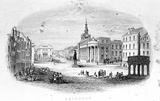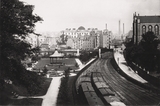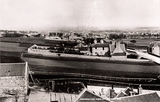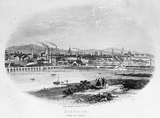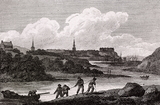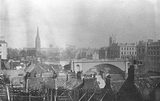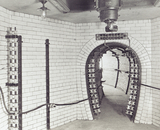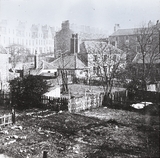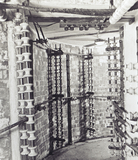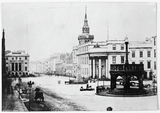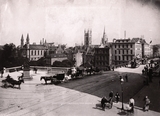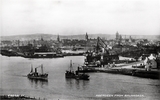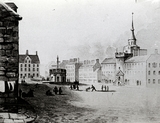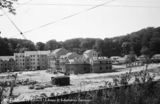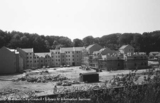|
Quick Search
|
Search Results
You searched for: Subject matches "General Views" or its children
171 items
items as
Schoolhill
13 Old houses skirting St. Nicholas churchyard once formed part of the south side of Schoolhill. They were demolished in 1884-85 as part of a street widening scheme and the present wall and railing stand in their place. On the other side of Schoolhill (centre) can be seen the roof and turrets of George Jamesone's House, demolished in 1886.
The book Aberdeen in Byegone Days: Views of Streets and Buildings, etc. with Letterpress Description (1910) by Robert Anderson (page 26) suggests that the building in the centre of this image was the home of Burnett Carr, the grave-digger and assistant to the sexton of St. Nicholas Church.
Newspaper references indicate that Carr, a well known figure, died on 31st May 1844 (Aberdeen Journal, 5th June 1844, page 3, column 2).
This photograph looks north and shows the back of Carr's old house. The Castlegate
16 Engraving of the Castlegate, c. 1850. The statue of the last Duke of Gordon, erected in 1844, was removed in the 1950s to Golden Square. Published by G. Shepherd, Broad Street, Aberdeen Castlegate at Christmas time
44 The junction of the Castlegate and Union Street at Christmas. Note the sunken public toilets at the right of the photograph. They were filled in prior to the pedestrianisation of the Castlegate. Denburn Valley
48 The Denburn Valley Railway, shown here on the right, was constructed in 1865-67. It runs from the Joint Station at Guild Street north through the valley. To the left of the railway lines is Union Terrace Gardens which were opened to the public on 11th August 1879.
The closeness of the railway led to the gardens being nicknamed the "Trainie Park". The bandstand shown here in the centre of the park was removed in around 1931.
The iron footbridge visible in this image allowed access over the Denburn and railway between Rosemount and the city centre. It was replaced by the Denburn Viaduct which was built in 1886, at the same time as Rosemount Viaduct, by engineer William Boulton. Part of the footbridge was moved and reassembled in the newly created Duthie Park.
This image also predates the construction of significant buildings on Rosemount Viaduct such as the Public Library and the Free South Church (both dating from 1892). In the background, on the left of the image can be seen the houses at the foot of a then longer Skene Terrace. These are on the site later occupied by the library and church.
To the right of those houses are Black's Buildings. Local historian Diane Morgan explains that they were "a small curving crescent of tall tenements, four and five storeys high, [and] sat below the Royal Infirmary, Woolmanhill, just west of the apex of the Woolmanhill triangle. (...) The houses were built in stages between 1789 and 1830, by the wine merchant James Black." (Lost Aberdeen: Aberdeen's lost architectural heritage, 2004). The tenements were pulled down in 1957.
Woolmanhill Hospital, designed by Archibald Simpson and built 1832-1838, can be seen in the background. Chimneys of Broadford Works, the textile factory located between Ann Street, Maberly Street and Hutcheon Street, are also visible. View of Aberdeen from Torry
57 View of the city from Torry, 1850, showing the railway viaduct and the city skyline. Drawn and engraved by W. Banks and Son, Edinburgh View of Old Aberdeen
70 Print of Old Aberdeen drawn by John Slezer. General view with the Crown Tower of King's College and the spires of St. Machar's Cathedral in the distance. The small building in the right foreground was the Snow Church - St. Mary ad Nives - which was demolished in the 1600's, although part of the burial ground survives. Old Aberdeen
71 A reproduced engraving showing the skyline of Old Aberdeen. The image looks north from around the lands of Sunnyside Farm.
In the foreground can be seen two agricultural labourers. On the skyline, going left to right, is the circular Powis Hermitage, on a hill, with its small spire, the twin spires of St. Machar Cathedral in the far distance, the tower of the Old Town House at the end of the High Street, which is protruding above the southern elevation of St. Mary's United Free Church.
Moving back along the High Street, the south facing front elevation, with bow windows, of Powis Lodge can be seen above the line of trees. The crown tower of King's College is across the street. The two minarets of the Powis Gateway are just next to it. Further along are the crenelations of Cromwell's Tower.
The tower on the far left of the image may be Dunbar's Tower.
The minaret gateway was finished in 1834 and this image likely dates from around that period. Union Bridge from Windmill Brae
123 This photograph by George Washington Wilson, looking towards Union Bridge, shows the old red-tiled roofed houses in the Windmill Brae area in the 1850s. Most of these were swept away with the construction of the railway and the building of Bridge Street around 1865-1867.
The house at the left, on the corner of Union Terrace, was owned by Harry Lumsden of Belhelvie and later by the Northern Club. Its site became part of that occupied by the Northern Assurance Company offices.
The spire of the Triple Kirks and the tower of the South Parish Church are visible in the background. Looking towards Rosemount from Skene Street
176 Looking towards Rosemount from Skene Street. Wallfield House can be seen towards the top left of the picture. View of Aberdeen from Cornhill
181 View of Aberdeen from Cornhill, c.1840. This picture was contained in a series of lithographs of Aberdeen published in 1840 by J and D Nichol, booksellers, Montrose. The elevated position of Cornhill provided one of the best points of view over the city. The idyllic rural scene in the foreground is in contrast to the array of smoking chimneys in the distance, interspersed with the spires of various buildings. In the middle is Broadford Textile Works with Hutcheon Street on the left. On the far right, there is the tall chimney of Rubislaw Bleachfield Works, which was demolished in July 1908. The spires belong to the East and West Churches of St. Nicholas, and the Tolbooth while, in the centre, there are the four turrets of the central tower of Marischal College and the tower of the North Church. The chimneys were evidence of the extent and importance of manufacturing in the city, while the western suburbs were the most attractive, with beautiful villas whose residents were often those citizens whose wealth came from these industries. An Aberdeen Corporation Electricity Works electricity tunnel
308 An Aberdeen Corporation Electricity Works electricity tunnel Dee Village, c.1898
312 Dee Village was a self contained hamlet located at the bottom of Crown Street. Originally Dee Village had grown up to cater for the workers of the nearby pottery and brick works in the Clayhills. The photograph was taken in 1898 just prior to the demolition of the complete village to make way for the new electricity station at Millburn Street. The entrance to a Cable Subway, Aberdeen Electricity Works, Millburn Street. c.1905
313 In 1889, Aberdeen Town Council received the first applications by companies wishing to supply electricity . They decided to operate their own system, which was inaugurated in 1894 at Cotton Street. The rapid increase in demand led to the purchase of a new site in 1901 and Aberdeen Electricity Works at Millburn Street were built. In 1895 nearly 160,000 units were generated, rising to 5 and a half million by 1907. This photograph shows the entrance to the Cable Subway running from the works in the line of Crown Street and Justice Mill Lane for 1500 yards. It was capable of accommodating all the feeder cables required for the northern and western districts of the city, and was believed to be the largest of its kind in the UK. When the Electricity Act of 1947 came into force on 1st April 1948, generation of electricity transferred to the North of Scotland Hydro Board. The Castlegate looking down Union Street
385 The Castlegate looking down Union Street. The Market Cross is in the foreground. The spire of the Tolbooth is seen on the right, while the new Town House has yet to be built. This dates the image to before 1867, the year demolition of the shown building began. |




